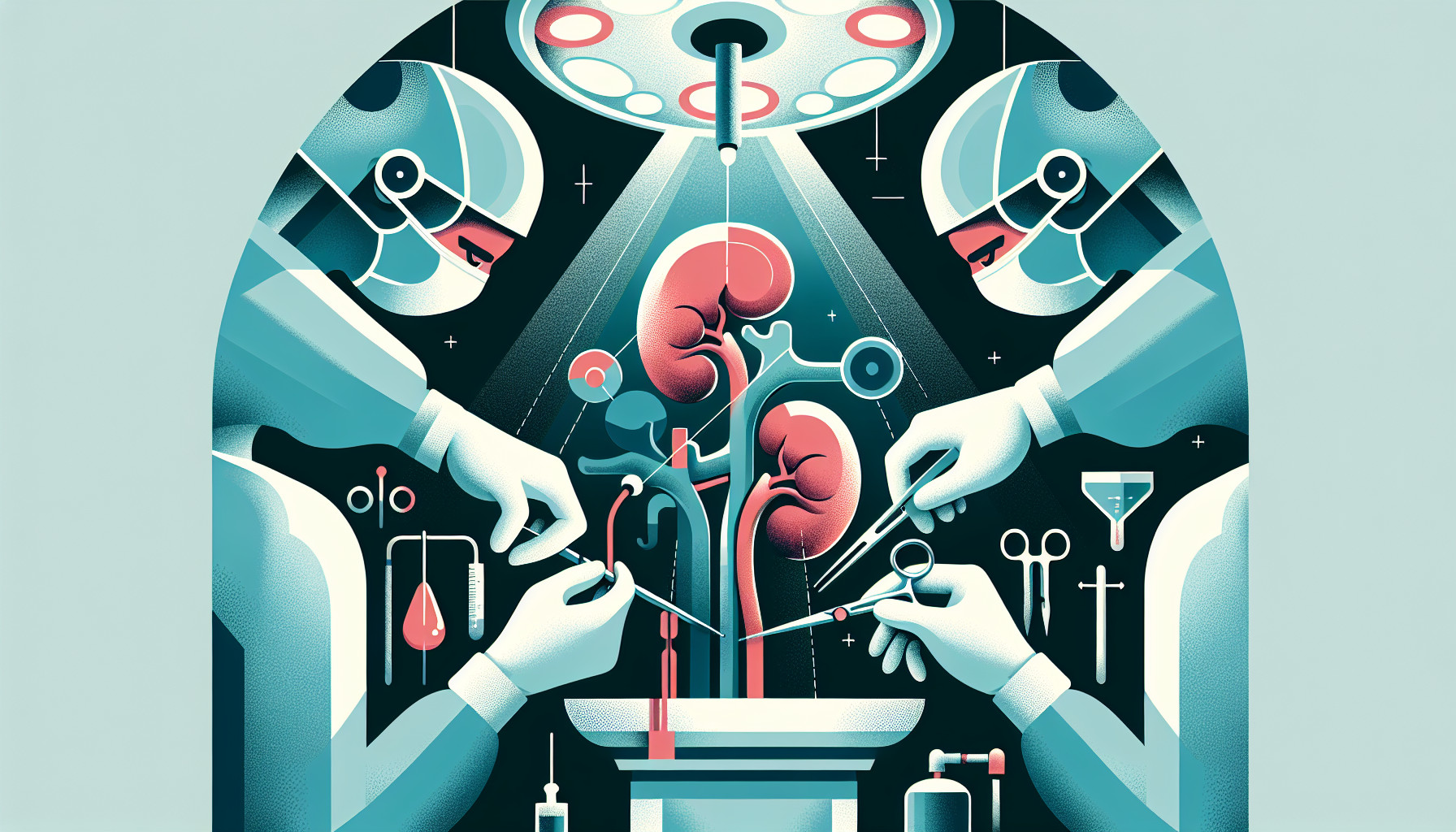Our Summary
This research paper looks at two different surgical methods used for kidney transplants: robotic-assisted laparoscopy and traditional laparoscopy. The goal is to see if one method is better than the other.
The researchers examined 12 different studies and found that the time taken for the operation and the amount of bleeding during surgery were quite similar for both methods. However, they found that the robotic method took a little longer during one specific part of the operation, but the overall hospital stay was shorter and patients reported less pain.
In conclusion, the study suggests that the robotic method is a good alternative to traditional laparoscopy for kidney transplants. The time taken, amount of bleeding, complications and rates of needing to switch methods mid-surgery are similar for both methods. But the potential benefits of the robotic method, such as shorter hospital stay and less pain, need to be examined more in future studies.
FAQs
- What are the two surgical methods for kidney transplants discussed in this research paper?
- How does the robotic-assisted laparoscopy compare to traditional laparoscopy in terms of operation time, bleeding, and patient recovery?
- What are the potential benefits of the robotic method in kidney transplants that need to be further examined?
Doctor’s Tip
A doctor might tell a patient undergoing laparoscopic nephrectomy that the robotic-assisted laparoscopy method may result in a shorter hospital stay and less post-operative pain compared to traditional laparoscopy. They may also advise the patient to discuss the potential benefits and risks of both methods with their healthcare team to determine the best approach for their individual situation. Additionally, the doctor may emphasize the importance of following post-operative care instructions to promote a successful recovery.
Suitable For
Patients who are typically recommended for laparoscopic nephrectomy include those with:
- Small to medium-sized renal tumors that are localized to the kidney and have not spread to surrounding tissues
- Non-functioning or diseased kidneys that need to be removed
- Kidney donors who are donating a kidney for transplantation
- Patients with benign kidney diseases such as polycystic kidney disease
- Patients with kidney cancer that is confined to the kidney and has not spread to other organs
It is important for patients to undergo a thorough evaluation by a healthcare provider to determine if they are suitable candidates for laparoscopic nephrectomy. Factors such as the size and location of the kidney tumor, overall health of the patient, and any previous abdominal surgeries may influence the decision to undergo laparoscopic nephrectomy.
Timeline
Before the laparoscopic nephrectomy:
- Patient undergoes initial consultation with a urologist to discuss the need for surgery
- Patient undergoes pre-operative testing, such as blood tests and imaging scans
- Patient receives instructions on how to prepare for surgery, including fasting and medication adjustments
- Patient may need to stop taking certain medications before surgery
- Patient arrives at the hospital on the day of surgery and undergoes pre-operative preparations, such as anesthesia administration
During the laparoscopic nephrectomy:
- Surgeon makes small incisions in the abdomen and inserts a laparoscope to view the kidney
- Surgeon removes the kidney using specialized instruments
- Surgery typically takes a few hours to complete
- Patient is monitored closely during and after the surgery for any complications
After the laparoscopic nephrectomy:
- Patient is taken to the recovery room and monitored for any immediate post-operative complications
- Patient may experience pain and discomfort, which is managed with pain medications
- Patient is encouraged to start moving and walking shortly after surgery to prevent blood clots and promote healing
- Patient is discharged from the hospital within a few days, depending on recovery progress
- Patient follows up with the surgeon for post-operative care and monitoring, including wound care and potential complications
Overall, the laparoscopic nephrectomy procedure typically results in shorter hospital stays, quicker recovery times, and less pain compared to traditional open surgery methods.
What to Ask Your Doctor
Some questions a patient should ask their doctor about laparoscopic nephrectomy include:
- What are the potential risks and complications associated with laparoscopic nephrectomy?
- How long will the surgery take, and what is the expected recovery time?
- Will I need to stay in the hospital after the surgery, and if so, for how long?
- How will my pain be managed after the surgery?
- What are the potential long-term effects of having a kidney removed?
- Will I need any follow-up appointments or tests after the surgery?
- Are there any specific lifestyle changes I should make after the surgery?
- Are there any alternative treatment options to consider?
- How experienced are you in performing laparoscopic nephrectomies?
- Can you explain the differences between robotic-assisted laparoscopy and traditional laparoscopy for kidney transplants, and why you recommend one method over the other?
Reference
Authors: Hinojosa-Gonzalez DE, Roblesgil-Medrano A, Tellez-Giron VC, Torres-Martinez M, Galindo-Garza CA, Estrada-Mendizabal RJ, Alanis-Garza C, Gonzalez-Bonilla EA, Flores-Villalba E. Journal: Ann R Coll Surg Engl. 2023 Jan;105(1):7-13. doi: 10.1308/rcsann.2021.0357. Epub 2022 May 26. PMID: 35616429
